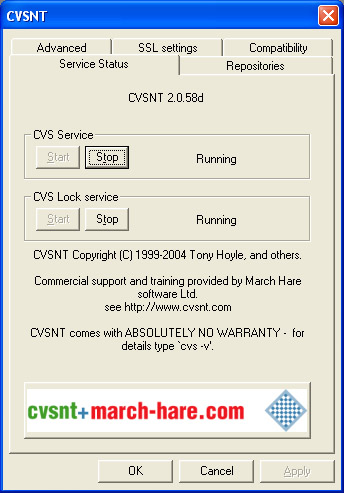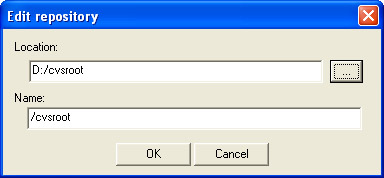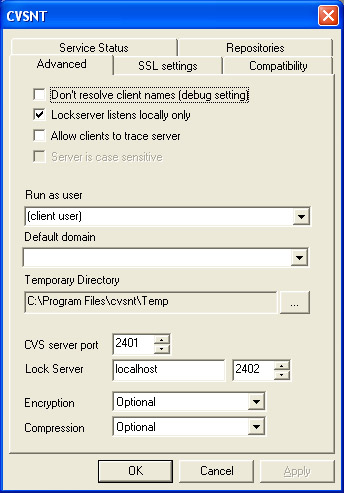How to Set up a Source Control on Windows without spending a dime.
by Jason Clark on December 28, 2004 9:00 PM EST- Posted in
- IT Computing
Installation
Installing CVSNT is a breeze - we'll cover a basic install and some of the configuration screens that you should take a look at after installation. First off, let's download a copy of CVSNT by going to this link and selecting the version for Windows. Once the download is complete, open the downloaded file and install the software, and just leave all the defaults selected throughout the install.Once the install has completed, open the Service Control Panel from the CVSNT program group in your start menu.

If your install went well, the CVS service and CVS lock service will both be running.
Creating your repository
A repository is simply a location in which to store your files. The repository will contain all of your modules, which we'll explain later on. In the Service Control Panel, click on the Repositories tab. Next, click the Add button and we'll create your repository. After clicking the add button, you will be asked to specify a location and name for your repository. The name is simply a descriptive label for the repository, and the location is where all of your files will be stored. After selecting the location and name, click "OK". You will be alerted that the location you chose is not a valid CVS repository. Just click "yes" and CVSNT will initialize the directory that you chose. After the repository has been created and initialized, click "OK" to close the Service Control Panel.
In our example, we created a directory called "cvsroot" on our d: drive and used that as our repository.
Customizing CVSNT Settings
The "Advanced" tab in the Service Control Panel allows you to customize the various settings that CVSNT offers. The defaults work quite well, but there is one particular setting that you may want to adjust. CVSNT, by default, runs on port 2401. If you want, you can change this to a different port. If you want to be able to manage your files remotely, you'll want to open a port on your firewall for the port that you select.
CVSNT Security
Security for the files that CVSNT manages is controlled by Windows. If you are installing CVSNT on a remote server that all your windows clients will use, we recommend that you use a NTFS partition for security and file integrity. The recommended protocol for Windows clients to connect to CVSNT is SSPI. There are other options for non-windows clients, which are covered in the CVSNT documentation.Depending on your network configuration, you'll need to assign the users/groups that you want to access the repository folder for which you created. When your users connect to CVSNT to manage their files, they will be challenged based on their Windows credentials if you use the SSPI protocol.










34 Comments
View All Comments
ncage - Wednesday, December 29, 2004 - link
ooops looks like i didn't read far enough..there are plugins for the ide. I will have to use it to see if the integration is as nice as it is with sourcesafe.ncage - Wednesday, December 29, 2004 - link
Least you guys aren't still using source safe ;). SourceSafe really sucks...its the access DB of the version control world. At work we have had so much trouble with sourcesafe corruption. We have the sourcesafe analyze utility running every night but if there is on developer that leaves sourcesafe open or VB6 with the sourcesafe add-in..the analyze will fail. The only thing nice about source safe is the IDE integration..you would have to build this for the free alternatives (if not already available) which would suck. Anyways, btw, i have used starteam and it ROCKS but very expensive.Stefpet - Wednesday, December 29, 2004 - link
SVN does not require Apache if you use svnserve. If you use svnserve you simply run it as a service similar to CVSNT.Jason Clark - Wednesday, December 29, 2004 - link
One drawback to Subversion is the Apache dependancy. There is no IIS support, at least last time I looked. It requires Apache or you have to setup a Synserve for remote access. From the time I spent with Subversion, CVSNT was much easier to setup and get going quickly.Just an FYI.
Jason Clark - Wednesday, December 29, 2004 - link
I've listed some of the other free alternatives, and some commercial alternatives.Yes, CVS lacks in some areas, but for the average user CVS is more than sufficient.
Damien - Wednesday, December 29, 2004 - link
CVS has many well known problems and is missing some key features. Being able to rename files/directories in Subversion and recording that name change as part of the file history is amazingly useful.Perforce is good from the ease-of-use angle, but it is expensive for more than two people. For that reason I moved to Subversion at work, having previously used both Perforce and CVSNT for several months previously.
Jason Clark - Wednesday, December 29, 2004 - link
CVS is still very widely used and works very well. Subversion is one of many alternatives, we discussed CVS. Subversions commands are very similar to CVS, so if you get your feet wet with CVS, Subversion should be a piece of cake.Stefpet - Wednesday, December 29, 2004 - link
I would also like to recommend Subversion (http://subversion.tigris.org/) instead of CVSNT. There is also a TortoiseSVN so you may use SVN exactly as described in this article.Perforce is also perfect if you need a good and easy to setup system for handle your own source-code. However, if you need more than 2 users than prepare to shell out loads of cash.
lysinewf - Wednesday, December 29, 2004 - link
Perforce! it's free for 2 users.Souka - Tuesday, December 28, 2004 - link
Subversion? Do share......